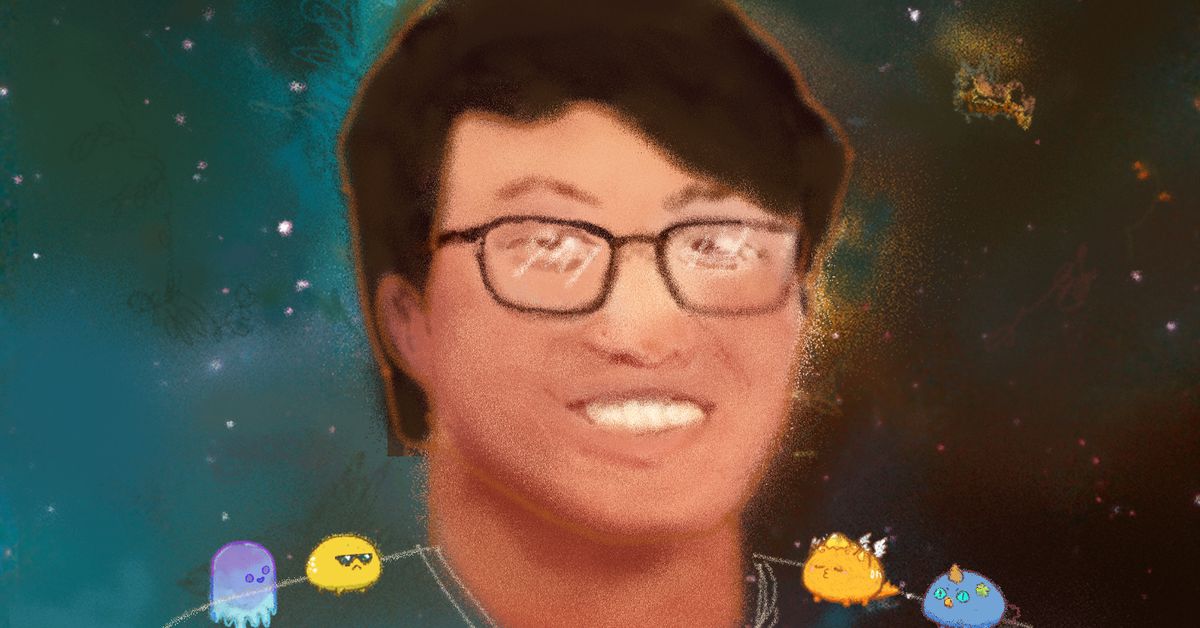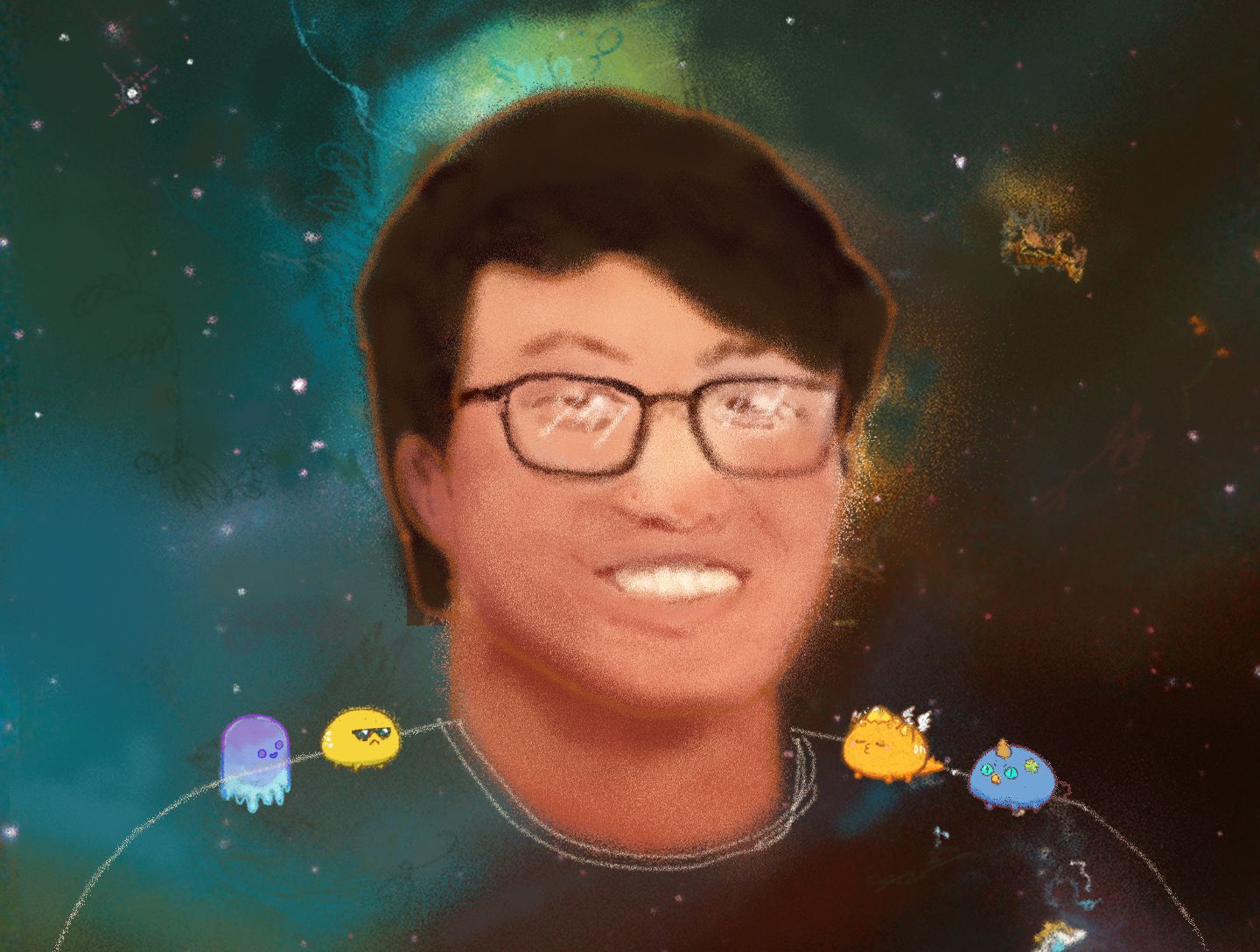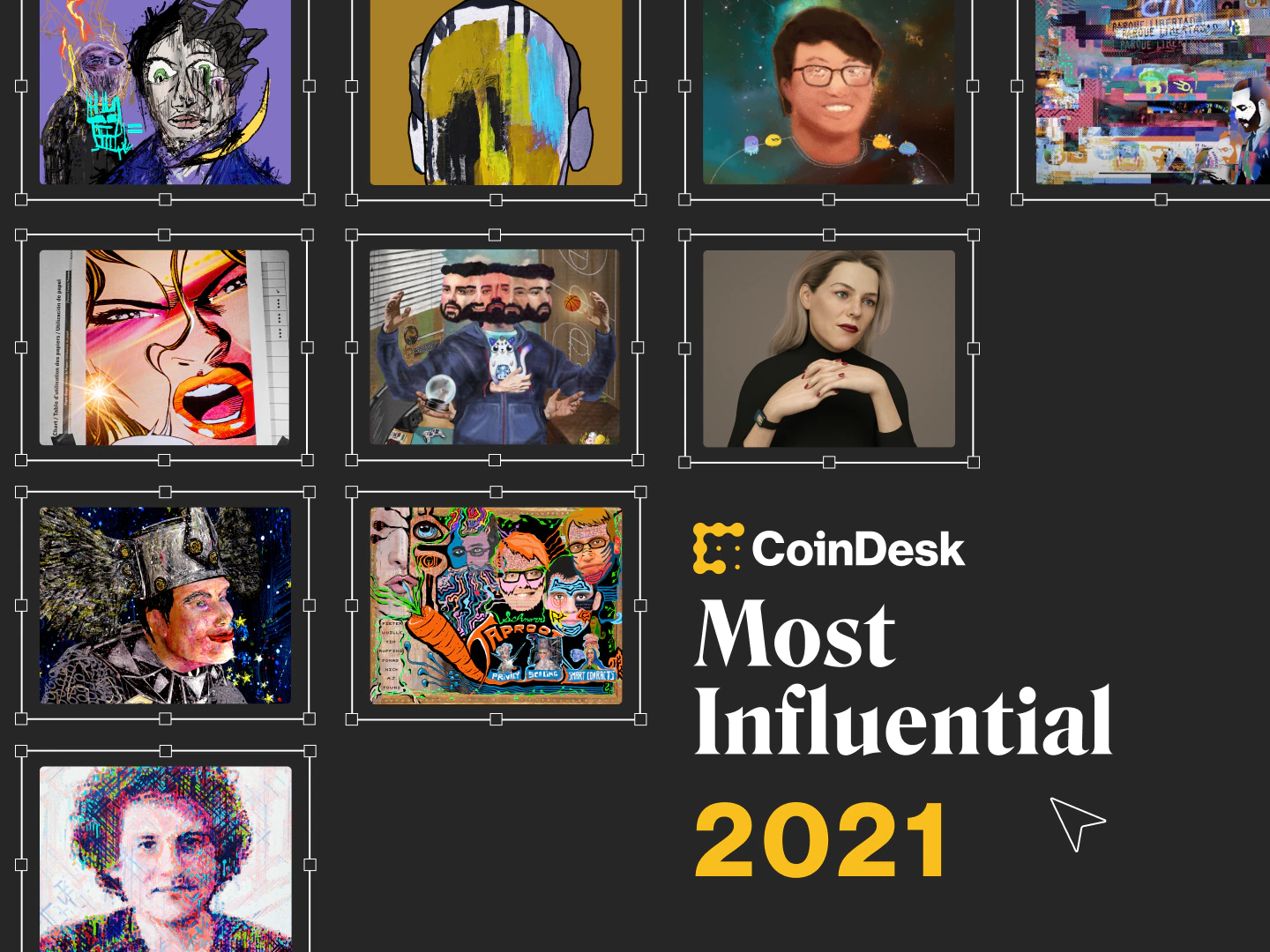Trung Nguyễn was intrigued by CryptoKitties because it combined something he loved – games – with something he hated – blockchain. It was late 2017 and the initial coin offering (ICO) boom was in full swing. All he saw were bad actors trying to scoop up a lot of money. In his eyes, the entire point of most ICOs was only to raise funds and all the applications were boring. Just fintech stuff. Numbers on a screen.
This article is part of CoinDesk’s Most Influential 2021 list. Matias Romano Aleman’s portrait is up for auction at Foundation, with a portion of the proceeds going to support mental health initiatives through The Giving Block.
But Nguyễn couldn’t help feeling curious about the idea of applying blockchain technology to something fun. So he went through the pain of buying ETH (the native token of the Ethereum network), setting up a MetaMask wallet and buying his first Kitty. The game itself was very simple – kind of like playing Nickelodeon’s Neopets with the added novelty of cryptocurrency transactions. Compared with other titles that Nguyễn had loved, including real-time strategy games like Red Alert and Age of Empires, and multiplayer online battle arena games like DotA, CryptoKitties left Nguyễn somewhat underwhelmed.
His inner engineer, however, was utterly enamored with the complex breeding mechanics underpinning the digital cat craze. CryptoKitties were non-fungible tokens (NFTs) represented as a unique long number, their genetic code, on the Ethereum blockchain. No two Kitties were created equally; each feline was defined by its set of “cattributes,” with unique physical traits and a personality all its own. And when Kitties would “breed” together, their genes would combine so that the offspring would have some mix of those cattributes, based on their lineage.
This presented a fascinating puzzle for Nguyễn, and would eventually inspire him to create Axie Infinity, the breakthrough game that popularized play-to-earn video games and catapulted the entire blockchain gaming sector into the spotlight this year.
Using what limited information he had about the existing Kitties that had been born, and the genes of their parents, Nguyễn began to map the data back to the source code to learn how the breeding algorithm worked and understand the exact probabilities of breeding specific offspring with desirable traits.
“It’s a pretty natural thing with being an engineer, because we see things at a deeper level,” Nguyễn said, explaining how the urge to unravel the mystery is innate within him. “We try to understand everything happening behind the scenes, instead of just seeing the surface.”
That has long been true of Nguyễn. He represented Vietnam in Yekaterinburg, Russia, at the 2014 International Collegiate Programming Contest (ICPC) – the oldest, largest and most prestigious programming contest in the world. Those who make it to the finals are the Olympic athletes of their field.
Entering those kinds of competitions is Nguyễn’s idea of fun. Something of an academic adrenaline junkie, he revels in the thrill of going up against other brilliant minds to push the limits of his own abilities. The task of reverse-engineering the CryptoKitties genome was just another technical challenge, and once he saw how the technology could be used to create something fun and meaningful, it changed his mind about blockchain technology.
With the belief that blockchain adoption would come through simple, elegant, decentralized applications, rather than from boring financial software, Nguyễn came up with the idea to build a game of his own – similar to CryptoKitties but more exciting. He reached out to Tu Doan, better known by his pseudonym, Masamune, and pitched the idea.
Years earlier, Nguyễn and Masamune had been co-founders in Lozi, a venture capital-backed social network for food bloggers. Existing media articles say they were childhood friends, which is untrue, but it’s easy to see how the confusion came about. The similarities between their backstories is uncanny. As kids, both were heavily influenced by Japanese culture – they loved Pokémon, devoured manga (Japanese comics, cartoons and graphic novels) such as One Piece and played Asia’s answer to “Magic: The Gathering,” the collectible card game “Yu-Gi-Oh!”
They also loved to make their own games and get their school friends to play them. While Nguyễn drew characters on trading cards, Masamune liked to create board games, gluing his original avatars to Vietnamese coins for the game pieces. Masamune also enjoyed creating creatures out of food, using toothpicks to stick accessories into their potato bodies.
During their Lozi days, the two often discussed their shared passion for video games. As a hardcore gamer, Nguyễn researched the games he played, picking apart the mechanics and rules, while Masamune got into the storylines and graphics. It was then that Masamune told Nguyễn about his dream to build a video game of his own someday. They even entered a hackathon and created a game inspired by the mid-1980s multi-directional shooter on Nintendo Entertainment System, “Battle City.”
Unfortunately, they didn’t win, and they came to the realization that they weren’t particularly good at making games (perhaps not surprising, given neither had a prior background in game development). But what they lacked in experience, they made up for in enthusiasm. The experience left them both with an itch to do more.
As for Nguyễn’s new blockchain game idea, Masamune didn’t quite understand the underlying technology, but he was excited about the prospect of making a game with Nguyễn. He went home from their inaugural executive meeting and sketched the first thing that came to mind: a mix between his pet axolotl (commonly known as the Mexican walking fish) and the food art he used to make as a kid. The result was the first-ever Axie, Puff.
See also: Former Tron Exec Launches Play-to-Earn ‘Mafia’ Game
For the first few months, while it was just the two of them, Masamune came up with all the original creative ideas and fed them to Nguyễn, who used his math skills to balance the game economics. Eventually, when they started to gain some traction – around 1,000 early supporters and $500,000 in committed funding – Nguyễn suggested Masamune should leave Lozi to work full-time on Axie. Masamune was nervous about quitting his job because he wasn’t doing well financially and had no savings. But Masamune was confident in Nguyễn’s abilities, and he felt the risk was worth it if it meant getting the chance to pursue his lifelong dream.
Talent management
In early 2018, Jeffrey “Jiho” Zirlin went poking around the Discord messaging app looking for something NFT-related he could add to his CV. Before that, he had been working as a recruiter in New York, placing quantitative traders at large hedge funds such as Bridgewater Associates and D.E. Shaw.
“Quants,” as they are known, are the rocket scientists of Wall Street and quite different from traditional investors. More likely to be seen wearing jeans than a suit, they rely on programmed investment strategies rather than on the judgment or opinions of human managers to make decisions. Zirlin’s specialty was to identify those high-functioning souls who had the ability to think with both sides of the brain – equally analytical and methodical as they are creative and artistic.
Joining the Axie Discord as a player, Zirlin immediately recognized Nguyễn as the quant type. Going back to scour his direct messages, Zirlin saw that he and Nguyễn had already connected, when Zirlin was working as growth lead for a now-defunct project called KittyHats, which sold ERC20 accessory tokens to deck out your CryptoKitties in anything from beanies to Yeezys.
CryptoKitties was one of the first success stories of the crypto era. The collectibles game was responsible for a sixfold increase in the number of daily transactions on the Ethereum blockchain – enough at the time to nearly break the network – and everyone was jumping on the bandwagon.
“Just how people today are asking ‘what will be the next Axie,’ back then we were thinking ‘what will be the next CryptoKitties,’” Zirlin remembers. It was an exciting time of experimentation, with KittyHats and other spinoffs, like KittyRace, a game that allowed CryptoKitties owners to race their pets against others for prize money, helping to germinate the burgeoning NFT industry. Some who worked on those early projects eventually took positions at future success stories such as OpenSea in New York and Dapper Labs in Vancouver, British Columbia.
Zirlin could have looked for work in the U.S., but he opted to relocate to Vietnam. That flips the script on the typical migrant narrative. Despite the higher costs of living, the cultural differences, language barriers and complex visa requirements, it’s usually the Vietnamese who leave home in search of life-changing opportunities abroad.
Today, the Vietnamese diaspora is the fourth-largest Asian immigrant group, and every year, many more leave the country to establish life in a more developed nation. In 2019 alone, Vietnam deployed more than 150,000 migrant workers. It’s a particularly popular path for young and well-educated professionals, with the brain drain making it increasingly difficult for Vietnamese companies to fill their top roles.
“Something special must be happening when you’ve got a guy who convinces an American and a Norwegian to drop everything and go to Vietnam,” said Zirlin, nostalgically, chatting with me via Zoom from his parents’ home in New York. He hasn’t seen Trung since February 2020, when he traveled outside Vietnam for Lunar New Year, and then COVID-19 meant he couldn’t get back into the country. But for the first two years of Sky Mavis, the company behind Axie, Zirlin shared an apartment in Ho Chi Minh City with co-founders Masamune and Aleksander Larsen.
For Larsen, who left his girlfriend behind in Norway and quit a good job building a “big and exciting space game” to go live in Vietnam and work on “a little pet game,” he remembers how awkward it was when Nguyễn came to collect him from the airport. Having collaborated exclusively online, meeting in real life was a bit weird.
They made small talk in the car and Nguyễn dropped Larsen at his hotel. Exhausted after the long haul flight and looking forward to a nap, Larsen went to take a shower. When he came out from the bathroom, Nguyễn was sitting there on the hotel bed, fully consumed by his laptop, coding. Larsen says it felt like he had stepped onto the set of a movie about a startup; the scene where they flashback to the scrappy beginnings of a world-changing success story to introduce the trope of the prodigious programmer, laser-focused on his mission. At that moment, Larsen knew he’d made the right decision.
Today, they have a team of 87 people around the world, with at least 60 of them based in Vietnam, working on multiple projects, including the game itself, an Ethereum-based sidechain called Ronin, a mobile wallet and a decentralized exchange called Katana. But back in those early days, Nguyễn did most of the coding and his do-it-yourself attitude came to shape Sky Mavis’ fundamental development principles. Anything that failed to meet his standards, he would say: We can build it better.
Case in point: Up until early 2020, Sky Mavis had been building Axie on the Loom Network, a scaling tool for Ethereum that became a popular platform for blockchain-based games that needed higher processing speeds and lower fees. But when Loom shifted to focus on enterprise use cases, closed down its public dapp (decentralized application) services and changed its architecture, Sky Mavis chose to abandon it in favor of building its own sidechain.
Their peers probably wondered why Sky Mavis would waste time building its own blockchain, when the founders could have quite easily used something that already existed. But Nguyễn wasn’t convinced that the existing sidechains and layer 2 platforms were the right fit for Axie. As for optimistic rollups or zk-rollups (another type of scaling tool), he was adamant that their launch would be delayed, and anyway, it would take too long for them to mature and achieve adoption. Ultimately, he was right about the rollups, and if Sky Mavis had waited, it wouldn’t have been able to provide the smooth and playable user experience for Axie gamers that Ronin has become known for.
The Ronin launch was a pivotal moment for the entire NFT gaming market and the key catalyst for Axie Infinity’s explosive growth from May to June, as daily active users reached 252,000 from just 38,000 at the end of April, according to Delphi Digital research data. The game is now approaching 3 million daily active users, with Ronin’s transaction volume at roughly four times the number of daily transactions of the Ethereum blockchain.
Ronin’s unveiling was a shining example of Nguyễn’s insatiable pursuit of excellence and a gutsy signal to the rest of the Web 3 world that Sky Mavis was thinking big.
Better than best
“The Last Dance” is a documentary series on Netflix that follows Michael Jordan and the Chicago Bulls as they went for their sixth National Basketball Association title in eight seasons. Considered by some to be the greatest basketball player of all time, Jordan was known for his unrelenting work ethic and competitive streak. Supremely dedicated and insatiably ambitious, he exhibited a strong desire to learn and continually become a better player throughout his career, famously pledging to his coach: “Nobody will ever work as hard as I work.”
When Larsen watched the documentary, he had a sense of déjà vu. Like Jordan, Nguyễn expects his team to push themselves, perform better, play to his standards and put in the same effort that he does.
Team members attest that Nguyễn is a stickler for quality with acute attention to detail. He works the hardest out of any of them, they say, has the highest expectations and implements near-impossible standards. For the first full year, all staff were contracted to work six days a week, Monday through to Saturday. His strictness strikes fear into some staff, but he does it to better the whole group. He’s as hard on himself as he is on others.
“It is the common goal of both people. Nguyễn wants your product to be great and you want it too,” explains Viet Anh (Andy) Ho, co-founder and chief technology officer of Sky Mavis. “But his standard may be higher than yours, so you develop the sense that you need to adjust your standard. You need to level up your own expectations.”
“He’s definitely a driving force for perfection, and sometimes you need that kind of leader,” Larsen says. “He’s kicked my ass several times. And if he’s failing, I can kick his ass too. That’s the level of competency and execution that we expect from each other.”
Adding to his tough exterior, Nguyễn is something of an enigma, fitting the stereotype of the introverted, reclusive genius. He rarely takes interviews, doesn’t interact much with investors, and leaves Zirlin and Larsen to handle external partners, such as Delphi Digital, the New York-based consulting firm responsible for Axie’s dual-token system; Smooth Love Potion (SLP), a utility token with unlimited supply, and Axie Infinity Shards (AXS), a governance token, designed to better incentivize community participants and stabilize the game’s economy.
See also: GameFi: How to Earn Crypto Playing Games Online
Nguyễn is allergic to distraction and believes in division of labor, which is why Sky Mavis has five co-founders. For outward-facing matters, the energetic Zirlin is devoted to community and the buttoned-down Larsen is in charge of fundraising and investor relations, while Nguyễn, Ho and Masamune handle internal operations in Vietnam.
Up until mid-2018, however, Nguyễn had to be more hands-on. He did the vast majority of the coding, product and user experience design, quality assurance and deployments. He gave feedback on artwork and was building community too; if you know someone who can remember the time when Nguyễn was in Discord every day, answering every question, you know that person is an OG (original gangster).
Live shot of @trungfinity planning @SkyMavisHQ's next move pic.twitter.com/U0dSb2IEph
— Gabby Dizon 🛡️⚔️ (@gabusch) April 17, 2021
Times were tough then. Money was running out, the co-founders didn’t pay themselves for a while in 2018, and the company almost didn’t make it. A pre-sale of Axie creatures as well as a land sale raised much needed capital for the fledgling startup, allowing Sky Mavis to sell NFT pieces of the game to its community members to fund development. A $1.5 million seed round announced in early 2019 that was led by Animoca Brands helped, too. But before that, Sky Mavis was receiving stink bids to buy 50% of the company for $1 million.
“We never stopped building,” Zirlin said. “There are people on the team who have worked every single day since 2018 with no breaks.”
While tough, Nguyễn emphasizes fairness and approaches problems with an analytical mindset, his colleagues say. Faced with a challenge, he requires his colleagues to develop a mental model to communicate and defend their rationale for the proposed course of action. That way, others can better understand the issue, interrogate it and contribute their ideas. Nguyễn leads by example in doing that, which is particularly important when he’s giving feedback on a subject seemingly outside of his wheelhouse – which he does. A lot.
“The decision-making process is always like that,” says Andy (Viet Anh Ho). “So when Nguyễn makes some decision, we understand why, and we understand there is some theory and strong foundations backing that decision.”
In the case of failure, the goal is to determine why it happened and how the experience can help the team to do better next time. That is a typical growth mindset. People with a growth mindset enjoy challenges, strive to learn and consistently see the potential to develop new skills, studies have shown.
Gifted
Every three years (not counting pandemic-related disruptions to the usual schedule), the Organization for Economic Co-operation and Development (OECD) conducts an exam that pits teenagers against each other in reading, mathematics and science. Typically, the results are unsurprising – those in richer countries do well, while those in poorer countries do poorly.
Vietnam, however, is an exception. It is the only low-income country in the world to compete at the same level as rich countries on international academic tests.
Often pointed to as a case study for effective policy, Vietnam has produced an entire generation of high performers. And for especially talented students, a cherry-picking system is designed to escalate them into high schools for the gifted. The competition to get into those selective schools is fierce, with thousands sitting through grueling entrance exams in the hope of winning a seat. Students sacrifice sleep to meet the demands of their study regimen and parents shell out money for tutoring. For some kids, the pressure to succeed is so overwhelming that they contemplate suicide.
Of all those coveted schools in Vietnam, Nguyễn attended the best of the best. Founded by a group of renowned Vietnamese mathematicians in 1965, the High School for Gifted Students under the Hanoi University of Science was originally established at a temporary war-time evacuation location. While North Vietnam was occupied by American troops, most educational institutions in the country were shut down for years, but the Vietnamese Mathematical Society continued to support research. It dug trenches next to makeshift classrooms, in case of attack.
The school now has a 5% acceptance rate, and its graduates go on to attend the most prestigious universities in Vietnam and abroad. Famous alumni include Professor Ngô Bảo Châu at the University of Chicago – the first Vietnamese recipient of the Fields Medal, which is generally known as the Nobel Prize of Mathematics.
Some students would sacrifice their right arm to attend the school, but Trung shrugs it off. He could have gone to any school he wanted, but he picked that one because it offered rooms for board on campus and was the farthest away from home. The idea of living far away was immensely appealing; home life was strict and he wanted to travel so that he could do things more freely. “Living a normal life is not interesting to me, it’s kind of boring” says Nguyễn, who struggled to talk to his parents about how he yearned to explore, come up with ideas and experiment. “Being a little rebellious is necessary because it helps you understand yourself more,” he says.
While his peers were sweating bucket loads, Nguyễn did little to prepare for his entrance exam. At school, he says he spent time during “flunked classes” to play video games with friends instead. Nguyễn’s teachers would call home to report his nonconformity, much to the dismay of his parents, though he wasn’t exactly a truant – it was the accelerated curriculum that couldn’t keep up with Nguyễn.
Meet me in the metaverse
Andy Ho, Sky Mavis’ fifth and final co-founder, joined Sky Mavis as CTO in August 2018. While he was the last to join the co-founding team, he had known Trung the longest. Well before the word “metaverse” became a buzzword, the two were teaming together to enter contests online and battle academic opponents around the world.
Those virtual contests were excellent practice to enhance their skills when preparing for elite school-level competitions, such as the National Olympiads. They were also an escape for unusually gifted and talented teenagers like Nguyễn and Ho, who found it difficult to find and connect with other people in their hometown who understood their way of thinking.
After high school, Ho attended university in Singapore, was selected to compete at the 2015 ICPC in Morocco and secured internships in the United States with Google and PayPal. But the quality of life overseas was never as good as Vietnam, and Ho couldn’t help feeling like he wanted to return home someday. He finally made the leap when he saw that Nguyễn was working at the Ho Chi Minh City office of Anduin Transactions, a San Francisco-based company. Anduin paid well and was obviously hiring talented people, and so Ho applied, too.
But little more than two years into the job, Ho found himself confiding in Nguyễn, admitting he was bored with financial software and yearning to do something cooler. Having quit Anduin some months earlier to lead Axie full-time, Trung seized the chance to win Ho onto his team.
See also: Play-to-Earn Is Already the Biggest Star in the Metaverse
“This is just the beginning,” Nguyễn said. “We have the chance to work together and compete against other teams across the world,” he told Ho, pitching the Sky Mavis mission and vision like it was just another programming competition. Ho was sold and he promptly handed in his resignation at Anduin Transactions. That was a pivotal moment for Nguyễn, finally allowing him to feel like he could loosen his grip and let someone else take the lead on developing operations.
Throughout 2021, the team has soared to higher and higher heights, raising a $7.5 million in a Series A funding round that was led by Libertus Capital and $152 million in a Series B round that was led by Andreessen Horowitz (a16z) and Accel Partners. With a truly global strategy from day one – less than 3% of Axie’s 2.6 million daily active users come from inside Vietnam – the company’s premier game has hoovered up players from every corner of the earth in a way that has never before been seen in blockchain-based gaming.
Their success has buoyed Vietnamese industry, too, fueling local job creation and spurring a wave of startup innovation. A slew of new indie game studios are now opening up for business. Cyball, Sipher and Thetan Arena are three examples of blockchain gaming titles to come out of Vietnam in recent times. It’s rumored that some VCs are even setting up funds dedicated to this new breed of Vietnamese-born blockchain games.
These are the fruits of Vietnam’s long commitment to science and technology and investment in education. A genius like Nguyễn, nurtured by a system that was designed to breed excellence.
Big thanks to Yat Siu, Chris Verceles and Nathan Smale for their research assistance.
DISCLOSURES: The author holds a range of cryptocurrencies and NFTs, including (but not limited to) AXS, and works with play-to-earn clients including Yield Guild Games (YGG), Animoca Brands, Blockchain Game Alliance, Breeder DAO, and others.






